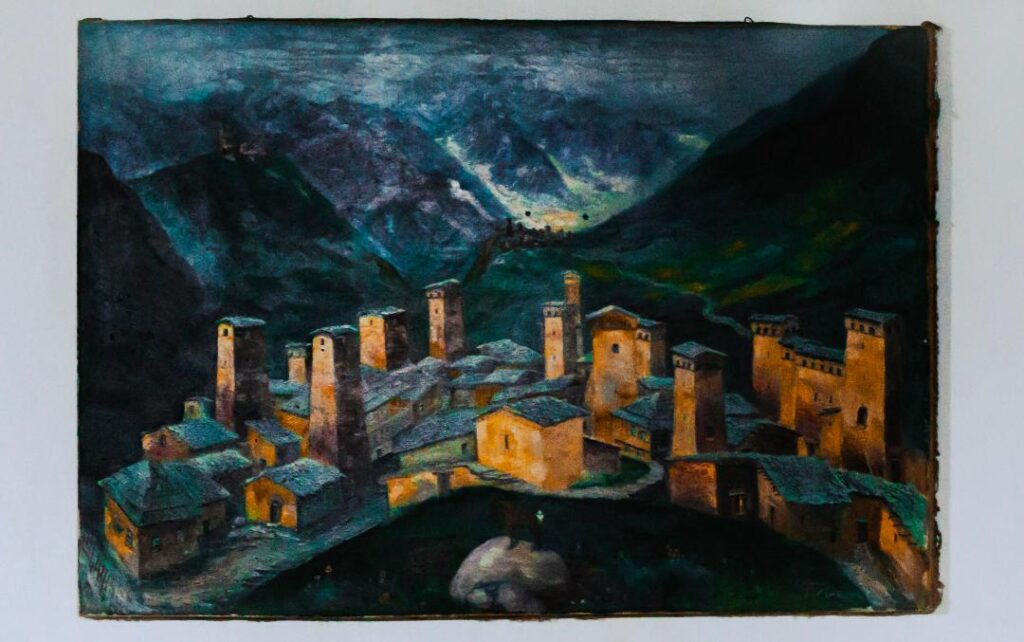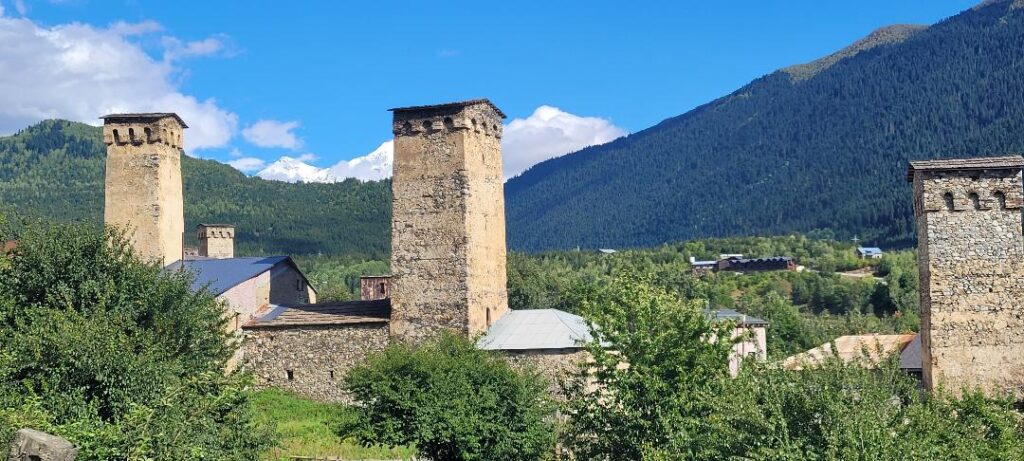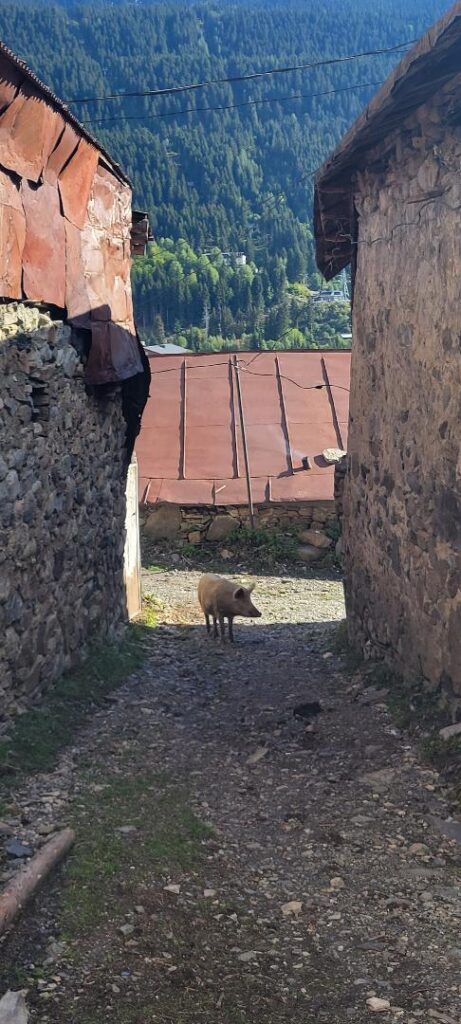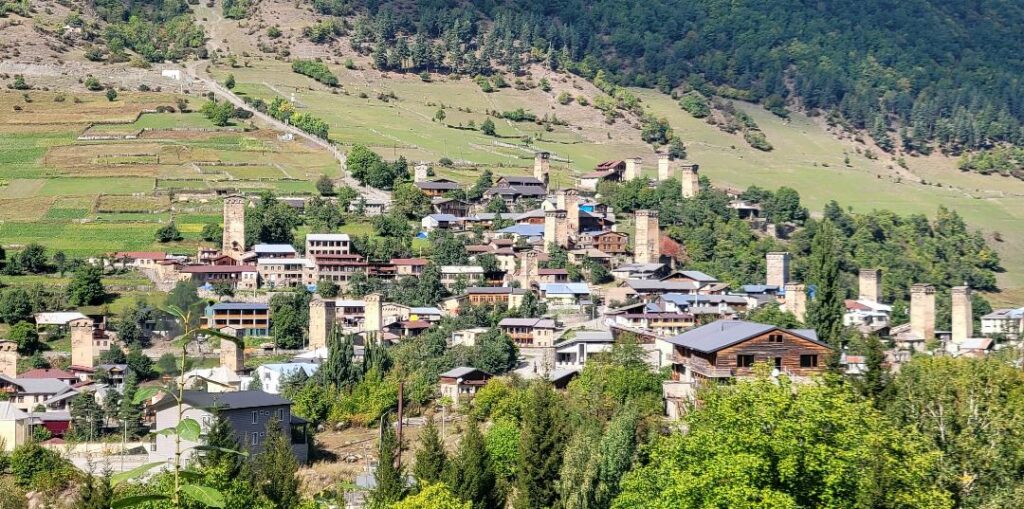
Georgians love to host a guest!
On a warm September day, my friend Asia and I visited a city of Mestia in the country of Georgia. Located in the Caucasus mountains, Mestia is a small townlet with two parallel roads, a few good restaurants, and a couple museums. After purchasing two strong cappuccinos at Café Laila on Seti Square, Asia and I decided to explore. Our interest was drawn by Svan Towers that dominate the landscape. These towers were built between IX and XII centuries as defensive structures and are still owned by private residents of Mestia; they are often connected to their family houses.

Shortly into our adventure we stepped off the main paved road onto a rocky-path that was winding between local dwellings like a dirty crusty snake. As we hopped around to avoid piles of excrements left behind by domestic-animals, we came upon a Svan Tower that appeared to be open to tourists. Allowing prior visitors to come down a wooden ladder, Asia and I stepped up to the second floor of the rocky five-story structure which was connected to a family house. At the entrance to a dusty room stood a smiling pre-teenage girl who greeted us in a clear spoken English.
The young girl was standing next to a table upon which we noticed a sign indicating that visiting the tower costs five Lari which translated to less than two US dollars per person. We dug in our packets but could not find small coins, only bigger Lari bills. The girl noticed our dilemma and quickly offered in her flowing English that we would not need to pay the full price. That was not an acceptable solution for Asia and I; we wanted to pay the requested amount for our visit and definitely did not want to short change the family. As we completed the payment the girl smiled and apologized for the mess in the tower. That apology was not necessary because we were hoping for a local experience; cold crumbly walls of the tower filled with dancing specs of dust coming from a pile of hay stocked in the corner of the room was definitely a local experience. The girl said that as long as we are careful, we can climb all the way up to the roof.
We proceeded up a steep shaky wooden ladder to the next floor. While climbing we noticed that the higher we went the thinner the stone walls became, explaining the tower’s tapering appearance. The floors on each contignation were covered with sandy dirt that got all over our hands and clothes. Dusty specs were making their way into our nostrils tickling and making us sneeze. The higher we climbed the shakier and more unstable the ladders felt and the openings between floors became tighter and more difficult to squeeze through.

Asia and I stepped on the ladders one at a time with the other person shinning a light from a smart phone to assist with visibility, and holding the backpack to simplify the process of squeezing through a narrow opening to the next sandy floor above. We finally reached the uppermost level and looked around. On each wall there was an embrasure historically used for defensive purposes, but for us these openings served as entry points for sun rays that illuminated the pinnacle. A shabby Georgian flag was hanging from the roof reminding us where we were. Looking out through the embrasures we were rewarded with spectacular views in all four directions. To one side was the majestic Ushba mountain recognized by its beautiful twin spiral peaks, the opposite side offered a view of Mestia with the numerous Svan Towers spread out in the distance.

The climb up the tower was well worth it; but if the climb up felt difficult, the climb down was simply dangerous. Georgia is one of the remaining places in the world where personal responsibility trumps any concept of signing a waiver for dangerous activities. The rules are: be smart, know your abilities, or you just might get hurt and that is on you. Slowly, and with an abundance of caution we descended to the origin where the happy young girl once again greeted us with her sparkling eyes and a wide smile; she clearly enjoyed practicing her English. We pulled a ten-dollar bill and attempted to hand it to her to express our appreciation for the tour and her positive aura. We were surprised when the girl refused to accept the extra money. As frequent tourists, we are used to people stretching their hands out for tips, refusal of a gratuity was something new to us. We laid the ten-dollar bill on the table and politely explained that we very much enjoyed our visit to the tower, and based on our positive experience and her personal kindness we wished to reward her. There were smiles exchanged and we left the tower slowly proceeding down a ladder to the dirt-packed street below us.
As we were walking away, once again avoiding the animal excrements, a pig blocked our path. Our eyes met; the pig did not look especially mean or dangerous but we were not used to such a road hazard. At that moment our pre-teen tower hostess stretched out her neck from the second story door and called out to us; her parents would like to invite us for some milk and cheese. We politely declined as we were rushing to visit the House Museum of a top Soviet-area Alpinist, Mikhail Khergiani, and the day was running short. Thinking back, I wish that we would have accepted the invitation. Georgians believe that a guest is a gift from God and I only hope that we did not offend the family by making excuses and proceeding on our exploratory mission. We walked away marveling and trying to understand a culture where people who are not wealthy do not express greed for money but instinctually refuse a higher payment for their services. Neither I coming from the US, nor Asia coming from Poland could recall a recent instance where someone refused extra money; frankly, we usually experience the opposite.








